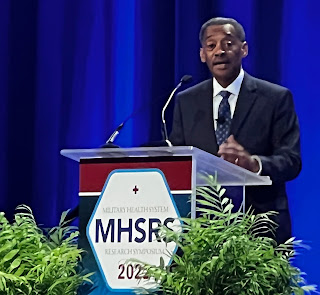Military Health System Research Symposium Draws Thousands of Researchers from Across the Globe
By Sarah Marshall
Thousands of scientists and scholars from around the world, including more than 150 researchers and leaders from the Uniformed Services University (USU) and countless USU graduates, represented the many innovative minds who attended this year’s 2022 Military Health System Research Symposium.
The annual event, which fostered collaborative conversations and novel ideas to advance research and optimize readiness, took place Sept. 11-15 in Orlando. It is the nation’s only scientific meeting completely focused on the unique health-related needs of the warfighter.
 |
| Dr. Jonathan Woodson, USU president, offers opening remarks during the MHSRS 2022 opening ceremony. (Photo credit: Sarah Marshall, USU) |
“We have a critical mission and together, through partnerships, we can meet the challenges to ensure the MHS cares for the 9.6 million beneficiaries, extending from the newborn and other family members to the Soldier, Sailor, Airman, or Marine … to our retirees and veterans,” Woodson said. “I look forward to that partnership and, most importantly, to ensuring we meet the needs of the warfighter now and into the future.”
Woodson explained that, using the knowledge gained through military medical research, he envisions four critical needs for the MHS to consider: integration, adaptation, education, and collaboration.
“We need a tightly integrated joint system,” Woodson said. This includes seamless transition from the frontline medic, integrating the latest technologies to ensure a knowledgeable handoff of wounded service members as they move through the different echelons, such that the continuum of care really is continuous.
Care providers must also be able to adapt and be armed with the latest technology to provide optimal care, including predictive and decision support tools, Woodson told attendees, saying that the next generation of providers need to be agile and adaptable by leveraging digital learning platforms. Finally, there must be collaboration – the heavy lifting cannot be done alone in the Department of Defense. “There must be partnership within the military and other federal entities, as well as with the civilian sector and other academic organizations,” Woodson said.
The underlying theme for these four readiness needs is “digital,” he said. “Our future is digital.”
“USU researchers are dedicated to health solutions, partnering with sister military labs, academia and industry, to reach the key goals I have outlined here,” Woodson said. “As the USU President, I see my role as ensuring we develop the future leaders of the MHS … who start their medical careers in a joint environment and who are comfortable working within multidisciplinary teams, such that it is built into their DNA. I also see USU as a critical translational lab for the MHS and greatly value the work we do with our colleagues in the military medical treatment facilities.”
This is the first year the symposium has been held in person since the start of the pandemic. More than 4,000 people registered for the meeting, including military representatives from allied partner nations such as Canada, the United Kingdom, Germany and Japan. Over the course of four days, more than 450 presentations covering roughly 60 topic areas relevant to military health and warfighter readiness were delivered. In addition to breakout sessions and podium presentations, the symposium also included two poster sessions highlighting an array of innovative research. Although its research work was displayed throughout the exhibit hall area during the three poster sessions, USU’s scientific presence was heavily emphasized in the Tuesday afternoon session by four solid rows of posters, arranged side by side, from the University’s Murtha Cancer Center Research Program (MCCRP), and the Surgical Critical Care Initiative (SC2i), which combined had more than 40 posters.
.jpg) |
| 2LT Sarah Walsh presented her work on Pathophysiology of Combined Traumatic Injury during the 2022 Military Health System Symposium. (Photo credit: Sarah Marshall, USU) |
“MCCRP is proud to have a record-setting 33 scientific communications being presented at this year’s MHSRS, including nine oral presentations,” said Dr. Craig Shriver, MCCRP director. “This unprecedented acceptance and opportunity to present our work to Military Health System leaders at this forum once again demonstrates that cancer is a readiness issue for the U.S. military.”
USU researchers also presented on an array of topics, such as COVID-19 and other infectious diseases, wound infection treatment, Acute Radiation Syndrome treatment, musculoskeletal injury, and traumatic brain injury. There were also presentations on combat casualty care, developments in pain management, mitigating bloodborne infections, expeditionary eye care, behavioral health interventions, warfighter nutrition, and health systems research.
Three recent USU alumni were selected to present their work during the MHSRS 2022 Young Investigator Competition on Tuesday afternoon. Army Capt. (Dr.) Haana McMurray (SOM 2021), Army Capt. (Dr). Andrea Moon (SOM 2019), and Army Maj. Jonathan Yost (PhD 2022) were among a dozen scientists who delivered talks on their research efforts. Yost, whose work was on “Ketamine Metabolit (2R, 6R)-HNK Provides Pain Reduction with an AMPA Receptor-dependent Mechanism and Alters AMPA Receptor Expression in the vIPAG,” won the competition and was selected to receive the 2022 MHSRS Young Investigator Award. In addition, several members of USU’s Department of Surgery earned the Best Poster, “Transcriptomic Profiles Associated with the Development of Heterotopic Ossification in Combat Extremity Wounds.”
Army Lt. Col. (Dr.) Bradley Dengler, director of USU’s Center for Neuroscience and Regenerative Medicine, who presented on blood-based biomarkers and other key lessons from the battlefield, was pleased with the research forum.
“This year’s MHSRS has been particularly meaningful. It’s the first time many of us have been together since the last MHSRS in 2019, and it’s powerful to see the work that’s been done since,” Dengler said. “USU’s cutting-edge research is well highlighted.”

.jpg)

.jpg)


